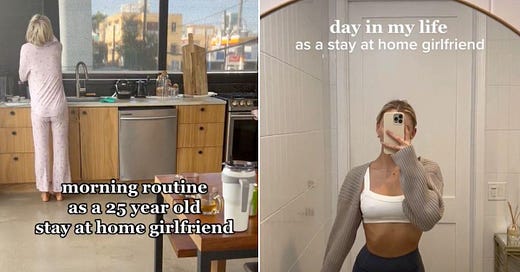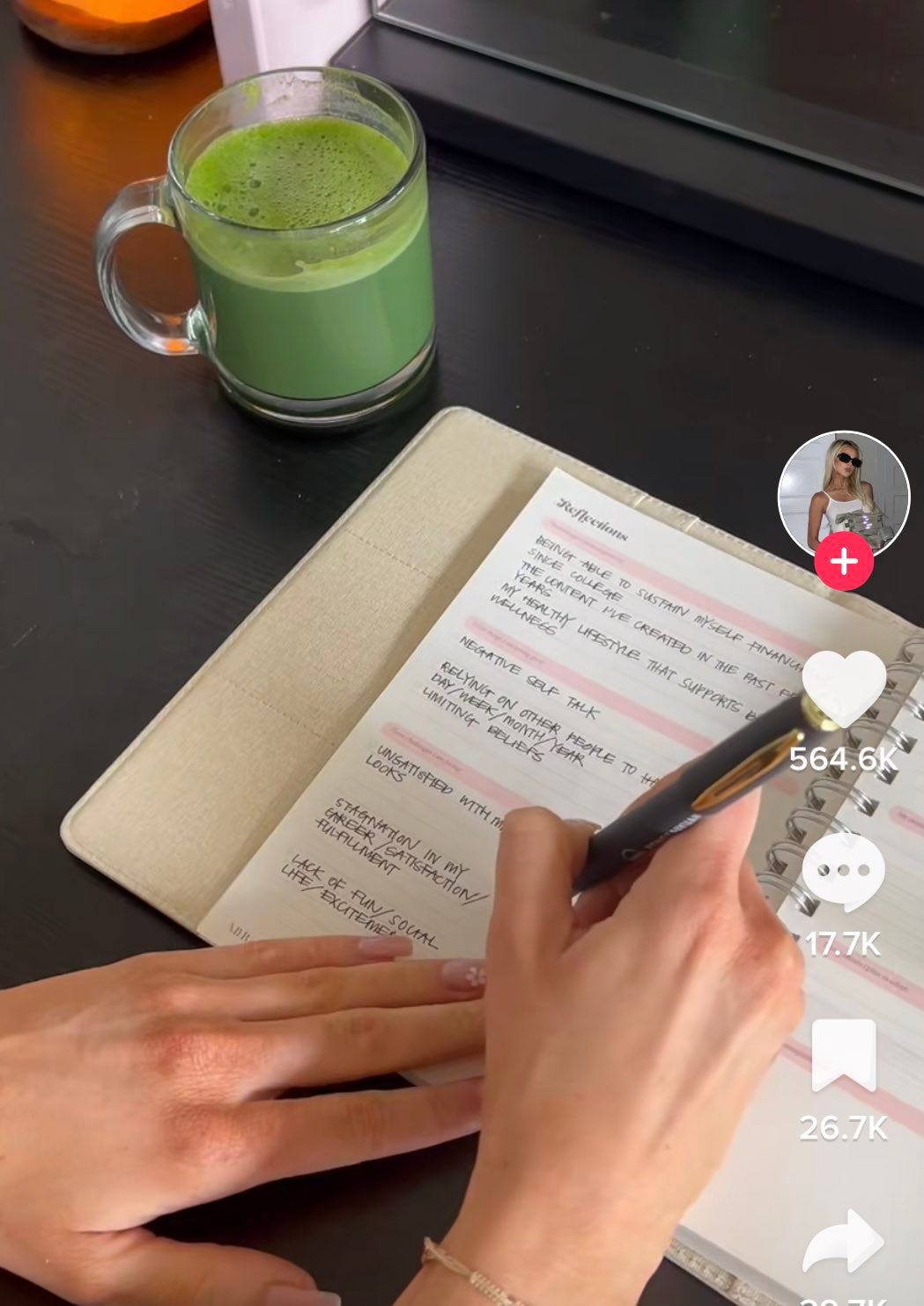A morning filled with copious creams and rouges rubbed onto your cheeks. A workout class. A load of laundry. A hearty breakfast prepared for your partner, a simple coffee and fruit for yourself. All before a day consisting of folding clothes, going on a neighborhood walk, and cleaning an already sparkling house. And then you wake up and do it again. No, this wasn’t meant to be a description of a traditional mid-twentieth-century American household. These are just a few standard images one might see in a “Day in the Life of a Stay-At-Home Girlfriend” video on TikTok. Yes - not “stay-at-home mom” - you read that right.
I’ve recently seen one of these videos, made by model and content creator Kendel Kay, go viral on my Twitter timeline. At the time I’m writing this, the video and tweet I’m referencing has about eight thousand quote tweets, each offering a new critical (and humorous) color and consideration to this peculiar and melancholy media. In Kendel’s “Day in the Life of a Stay-At-Home Girlfriend,” she runs viewers through her daily agenda in a robotic, monotonous tone of voice that has about as much excitement as a child being forced to eat their vegetables. Some of the checkpoints on Kendel’s daily agenda include making her bed, journaling, picking up coffee at her boyfriend’s “favorite latte place,” replying to some texts, folding and steaming her clothes, dropping her boyfriend off at the gym, “cutting up veggies to snack on,” and heating up soup for her boyfriend.
As the video goes on, I kept finding myself waiting for her daily activities to actually start. I mean, I make my bed, reply to texts, and prepare snacks every day too (I assume most people do), but they’re usually the sub-tasks I perform before getting into more complex activities. For this content creator, the “in-betweens” are the main plot points, shading the whole video in a rather gloomy and lifeless veil.
What makes this TikTok even more somber is the fact that in one of Kendel’s previous “Day in the Life of a Stay-At-Home Girlfriend” videos, she didn’t completely blur out what she was writing during her “journaling” portion of the day. The written pages read phrases like “unsatisfied with my looks,” “stagnation in my career/satisfaction/fulfillment,” and “lack of fun/social life/excitement.” This version of life that’s meant to be presented as aspirational on her social media feed - pilates classes, slow tasks, hanging around a clean house in earth-toned athleisure - juxtaposed with these raw, existential confessionals is chilling, to say the least.
The comments sections of these videos are typically mixed bags, though many of the most liked comments come from viewers expressing their jealousy of the stay-at-home girlfriend’s life. An extension of the online trends of “slow living” and “quiet quitting,” many girls and women online have been apt to reject the “girl boss” and “lean in” sentiments thrown their way via self-help and liberal feminist media. This type of “hustle culture” media has widely been called out for promoting unhealthy work-life balance habits, bolstering late-stage capitalism, and heightening a culture that already puts undue pressure on women to continuously self-optimize. When interviewed by Charissa Cheong for Insider, Kendel says this about her lifestyle:
This type of sentiment in tandem with trends like “cottage core” reflects a cultural hunger for presence and simplicity amid a modern world that is constantly in motion and demands people to equate professional accolades and wealth with personal fulfillment. Having the opportunity to decelerate and focus on the simple joys of preparing a meal and taking care of our bodies, loved ones, and homes can provide a sense of ease and mindfulness, as well as a feeling of control, particularly in a country and on a planet where so much can feel out of our control.
When given the option to work an overbearing job that you dislike or stay at home and lean into easeful, self-care-driven activities, the choice seems quite obvious. Nobody should have to spend the majority of their waking hours engaging in work that makes them feel miserable, and it's upsetting that that’s many people’s realities.
Another criticism of the “stay-at-home girlfriend” phenomenon is the idea that women choosing to engage in solely domestic tasks is setting women back and undoing western feminist progress of the twentieth century. I should make it clear that performing domestic chores is not some kind of decision: it’s a necessity. People need to eat food and live in a safe and sanitary environment to continue functioning in a healthy manner, and the effort it takes to make these conditions possible is work. Regardless of whether it’s paid work, domestic work is essential and important, especially when adding child-rearing to the equation. It’s also work that is not sex-coded in some kind of pre-determined biological or genetic manner. However, due to culturally conditioned gender roles, women still do the majority of the household labor - particularly grocery shopping, meal preparation, and cleaning - regardless of if they also work a paid job.
Work that happens in one’s home is important and deserves the acknowledgment and appreciation that paid work does. And I don’t think that enjoying cooking and cleaning as a woman is some kind of regressive, anti-feminist act, and thinking that it is is a bit reductive.
At the same time, while I think that people should be free to do what they want to do, intentionally putting oneself in a situation where they are permanently, financially dependent on a significant other isn’t a wise move. And promoting it as some kind of viable life path, particularly to younger, impressionable viewers isn’t a good decision either.
Relationships can end, sometimes unexpectedly. And being left with little to no work experience and no personal savings after being a stay-at-home girlfriend can make a break-up a much bigger problem than just the run-of-the-mill heartbreak. In the Insider article, I referenced earlier, Kendel Kay and Zoë Rae (another self-proclaimed “stay-at-home girlfriend”), say that they are not entirely vulnerable to financial ruin in the event of a break-up because they have small side hustles (including social media content creation) that allow them to have some personal savings. However, this information is not often discussed in their “stay-at-home girlfriend” TikTok content, making these women’s lives appear deceptive to viewers. Susceptible viewers (particularly younger ones) may receive the wrong impression about stay-at-home girlfriends' lives and could be influenced into pursuing a financially insecure path.
In addition, what I think is of significant note, is the fact that living this type of life may seem glamorous online and may even be somewhat enjoyable to some folks; however, Kendel’s journal entries are just a small insight into the potential lack of personal satisfaction that comes with living a life entirely catering to others.
I think that when asked to envision the stereotypical “stay-at-home” woman, many are apt to envision the 1950s American housewife image. Effortless pin-curls, shiny red lips doting over her adorable children with a perfect roast in the oven. White picket fence, golden retriever, the whole nine yards. What often isn’t included in these images is the anxiety and depression that many of these women experienced, leading to an uptick in the dissemination of drugs like Valium and Librium or “mother’s little helpers.” Handed out like candy to help women cope with the mundanity of their everyday tasks and feelings of lacking purpose. By the 1960s, women were being prescribed Valium twice as much as men. I wonder how different these women’s diaries would look from the stay-at-home girlfriends of TikTok.

When it comes down to it, I think modern feminist issues too often get watered down to conversations about choice, whether it’s discussions of abortion, plastic surgery, or the right to stay at home rather than contribute to an increasingly capitalist corporate America. And reducing these issues to the binary “right” and “wrong” answers strips them of the complexity they deserve. Do I think the stay-at-home girlfriends of TikTok should be coerced into working jobs they despise? No. But I’m also not fully convinced that their life choices are setting the best examples for others or taking some kind of progressive ideological stance against “hustle culture.”
All I can hope is that women find themselves in less at-risk situations and actively chose against them when given the opportunity. And that their diary entries start looking less and less like those of housewives of centuries past and more like a person who feels satisfaction and purpose through and through.
Since writing this post, I’ve gotten the opportunity to interview stay-at-home girlfriend and content creator Kendel Kay to expand on the ideas established in this article. Click here to read that post!






